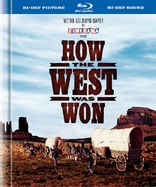How the West Was Won Blu-ray Movie
HomeHow the West Was Won Blu-ray Movie 
Warner Bros. | 1962 | 165 min | Rated G | Sep 09, 2008Movie rating
7.6 | / 10 |
Blu-ray rating
| Users | 4.7 | |
| Reviewer | 3.5 | |
| Overall | 4.4 |
Overview
How the West Was Won (1962)
A story following a family’s move West through generations.
Starring: Carroll Baker, Lee J. Cobb, Henry Fonda, Carolyn Jones, Karl MaldenNarrator: Spencer Tracy
Director: Henry Hathaway, George Marshall, John Ford
| Drama | Uncertain |
| Western | Uncertain |
| Adventure | Uncertain |
Specifications
Video
Video codec: VC-1
Video resolution: 1080p
Aspect ratio: 2.89:1
Original aspect ratio: 2.59:1
Audio
English: Dolby TrueHD 5.1 (48kHz, 16-bit)
English: Dolby Digital 5.1 (640 kbps)
French: Dolby Digital 5.1 (640 kbps)
German: Dolby Digital 5.1 (640 kbps)
Italian: Dolby Digital 5.1 (640 kbps)
Spanish: Dolby Digital 5.1 (640 kbps)
Spanish: Dolby Digital Mono
Spanish: 5.1=Castilian / Mono=Latin
Subtitles
English SDH, French, German SDH, Italian, Italian SDH, Japanese, Portuguese, Spanish, Danish, Dutch, Finnish, Mandarin (Traditional), Norwegian, Swedish
Discs
50GB Blu-ray Disc
Two-disc set (2 BDs)
Playback
Region free
Review
Rating summary
| Movie | 3.0 | |
| Video | 4.0 | |
| Audio | 4.0 | |
| Extras | 4.0 | |
| Overall | 3.5 |
How the West Was Won Blu-ray Movie Review
One of the most lavish Westerns of them all makes its way to Blu-ray with impressive AQ and PQ results.
Reviewed by Greg Maltz October 2, 2008Warner delivers the high-definition goods on its Blu-ray book edition of the epic How the West Was Won. The two-BD set features a version optimized for 2.89:1 aspect ratio on Disc 1 along with a "SmileBox" version on Disc 2 that offers the feel of the original Cinerama approach originally projected on curved, wraparound screens. Warner's BD package also includes a 40-page photobook with glossy, color pictures, production notes, actor photos, movie trivia, original drawings and memorabilia and more. Even without taking into account the vastly improved picture and sound quality of the 1080p, Dolby TrueHD 5.1 production, fans of the movie will find this package an important keepsake. It is a true labor of love from Warner--a step up even from the studio's other Blu-ray book editions, with great care and sensitivity shown for the historical significance of the film. No other western production before or after was as ambitious in scope. The cast boasted many of the biggest stars of its time, including John Wayne, Gregory Peck and James Stewart. One performance in particular seems inspired: Debbie Reynold's portrayal of Lillith "Lilly" Prescott, a doggedly independent woman who resisted settling in the country or going west until she found out she had inherited a gold mine. Reynold's good looks and strong vocals lent enormous entertainment value to the film.
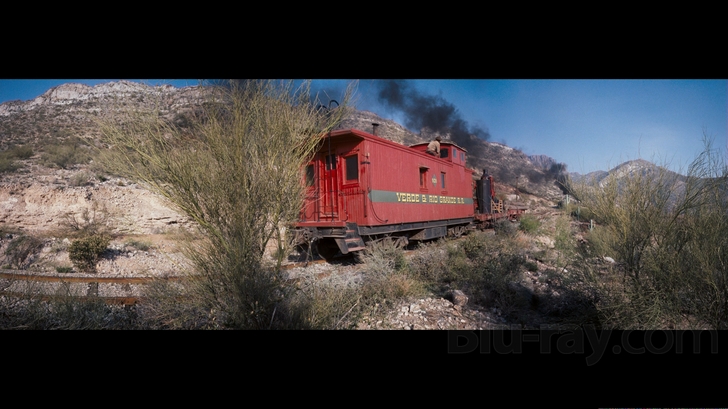
A steam train carrying a fortune in gold encounters problems as it chugs across the Arizona countryside.
How the West Was Won had its world premiere in London on November 1, 1962. Its U.S. debut was February 20, 1964. Video and audio characteristics are the main draw for me, with gorgeous landscapes and lush recordings of large ensemble instrumentation. Franklin E. Milton and the MGM sound department won an Oscar for "Best Sound". I find the character development and plot are the weak points of the film. It nevertheless earned James R. Webb an Oscar for "Best Story and Screenplay Written Directly for Screen". The story mostly follows three generations of the Prescott/Rawlings family through five distinct "acts": the settlers of the Ohio River valley; the gold rush (featuring wagon trains and Indian raids); the civil war; transcontinental railroad development; and the establishment of law and order in the Southwest. None of these subplots are particularly informative or even true to history. But each vignette is entertaining if not always set up or paid off. Part of the problem is that the entire movie had to be produced in 10 months, which made it impossible to use only one director. John Ford, Henry Hathaway and John Marshall each directed segments and the cinematography was handled by William Daniels, Milton Krasner, Charles Lang, Jr. and Joseph LaShelle. With so many key players involved, it's amazing the film has any cohesion at all.
The actors, directors and cinematographers involved are just the tip of the How the West Was Won iceberg. The film spanned 11 locations and involved 38 different departments at MGM-- 117 arts and professions and 253 skilled technical crafts. A big part of this effort was costume design. Pre-production tests involving Debbie Reynolds and Gregory Peck filmed at close range (2- 3 feet), proved that that machine stitching would be visible to audiences. To lend authenticity to the film, only hand-sewn, authentic fabrics and other wardrobe materials were used. The costume production for How the West Was Won is said to be "the most exacting assignment ever attempted for a motion picture". With detailed descriptions of such trivia, Warner's BD package--including both widescreen formats and the informative booklet--is an impressive keepsake to document all the work that went into this legendary movie.
How the West Was Won Blu-ray Movie, Video Quality 
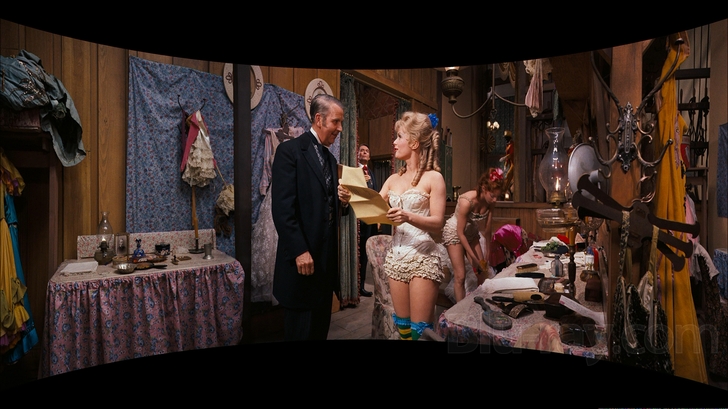
In a word, the picture was stunning. That applies to both the 2.89:1 format and the curved
screen smilebox simulation. For a 45 year old film, the Blu-ray picture quality is very good,
defined and vibrant. Some interesting anomalies are visible--occasional strobing/flicker, some
signs of two vertical seams linking three distinct areas of the film, and warping toward the sides
of the picture. These anomalies are due to the original Cinerama production, so it may be
instructive to describe this process. Cinerama involves three cameras aimed at different angles to
capture 146 degrees of horizontal planes and 55 degrees of vertical planes--meant to simulate
human vision. The idea was to project the film using three synchronized projectors onto a curved
screen to create a wraparound effect. To maximize color vibrancy, the color film for Cinerama was
manufactured by Technicolor, and the lifelike contrast really comes through in the transfer to
1080p.
Regarding the transfer, Warner produced a video master to capture the essence of the film's
original "Cinerama Roadshow" exhibition. This representation was achieved by combining the
three Cinerama filmstrips into a single, seamless 2.89:1 image that only occasionally shows
visible signs of separation between the three areas. How did Warner accomplish this? The original
negatives were each scanned at 2k resolution and digitally assembled to make a single 6k image.
"Digital software was created specifically for this restoration to resolve camera alignment and
image linearity issues inherent in the original photography," according to Warner. The studio
developed the "SmileBox" version using a rendering application that treated the 6k image as if it
was projected into a 3D wraparound screen, and output at 1080p for Blu-ray. Did it work? Yes.
Some warping visible in the 2.89:1 format is alleviated or reduced in the "SmileBox" format. I
don't wish to give the impression that the "SmileBox" completely fixes the warping issues, but
there does seem to be slightly less of a fishbowl effect. Once the viewer becomes accustomed to
this unusual display approach, it may be preferable, especially for home theaters with a projector
and large screen. Check out Disc 2 and judge for yourself.
The resolution generated from this approach, while not perfect, is actually better than some
modern films produced for Blu-ray release. Despite the problems alluded to earlier, specifically the
warping effect, the definition and depth is good. Motion blur tends to retain an analog quality that
I found less fatiguing to the eye than some DNR'ed movies, although it was difficult to focus on
some details in landscape shots. Watch the stampeding buffalo scene. Definition of the animals
suffers a bit, but static objects remain sharp. Skin color, foliage and other earth tones are
rendered gorgeously, with a richness not achieved in other Westerns from that era, such as
Butch Cassidy and the Sundance Kid. Costume textures and facial expressions are
captured very convincingly, often with superb detail.
How the West Was Won Blu-ray Movie, Audio Quality 
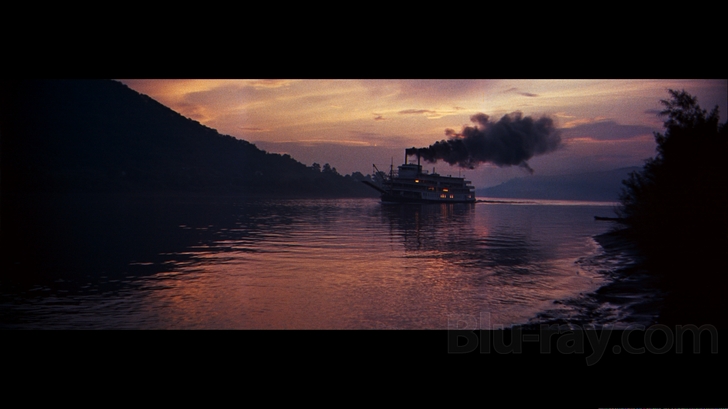
Further lending credence to the Blu-ray production credentials of How the West Was Won, Cinerama features multichannel sound. In fact, it uses seven channels of audio, which begs the question why Warner didn't issue a 7.1 track that would have been a better approximation of the original production instead of the 5.1 track included on both discs. The bulk of the sound is anchored up front, with only minor ambient material assigned to the rear channels. Orchestral arrangements of traditional American folk music are the most notable aspect of the soundtrack, although rushing rapids, stampeding buffalo, galloping horses and chugging steam engines are also prominent at different points in the movie. But the importance of music becomes apparent at the film's outset as the overture plays, referring to the West as a promised land. The strings and wind instruments have an analog quality with extended treble, although there is no denying that the large ensemble performances sound muddy or constricted, especially when a chorus of voices--Dave Guard and the Whiskeyhill Singers--and the full orchestra is used. Voices sound crisp and retain all the actors' identifiable characteristics. I had to laugh when I heard James Stewart's voice which has so much presence, warmth and clarity, because he does tend to slur some words and speak in a folksy braggadocio style for his role. HT fans will also enjoy the deep bass that rumbles from the LFE channel. The subwoofer gets a serious, window- rattling workout that augments many scenes, including white water rapids and stampeding buffalo.
How the West Was Won Blu-ray Movie, Special Features and Extras 
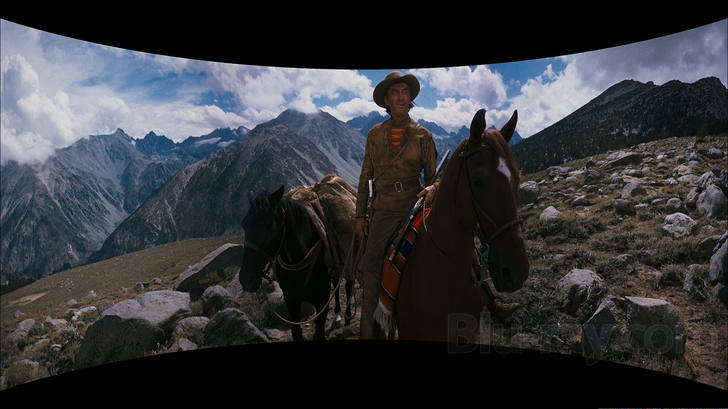
The inclusion of the "SmileBox" version on Disc 2 and the quality of the booklet make me inclined to rate the supplements highly, but beyond these perks, the BD package is actually a bit short on supplementary material. Some fans of the film will miss the pressbook, souvenir book and photos and postcards that came with the DVD Ultimate Collector's Edition. Disc 1 of the BD set includes the documentary "Cinerama Adventure", describing the technology and its developer, Fred Waller. The Blu-Ray also offers an exclusive Smilebox version of the film, a "bent" aspect ratio made to mimic the curved screen of the original Cinerama process. The audio commentary involves reminiscences from filmmaker David Strohmaier, Cinerama's John Sittig, music expert Jon Burlingame, stuntman Loren James and movie expert Rudy Behlmer, who gives perhaps the most comprehensive comments of all, dutifully augmented by the other commentators.
How the West Was Won Blu-ray Movie, Overall Score and Recommendation 
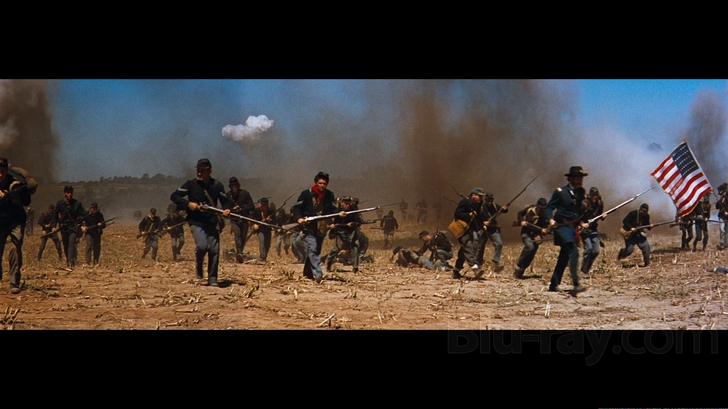
Ultimately, I felt torn about Warner's How the West Was Won two-BD set. Without taking anything away from the work that went into the original movie, I believe the production values of the Blu-ray book edition package may have outweighed the quality of the film itself. It's beautiful, visually and sonically, and the Cinerama scope is reproduced with great care. But I feel that other films in Warner's catalog--films with better acting, character development and plot lines--are more deserving of the attention to detail, treatment and transfer tendered to How the West Was Won. The clumsy manner in which the Civil War scenes were handled, for example, just begged for a more cohesive story. Ultimately, one must recognize the film's legendary status and importance in movie history. And that is why this BD book edition set is justified. Film buffs, western fans, collectors and even musical aficionados will find it a treasured part of their video library. And Warner deserves special recognition for delivering the curved "SmileBox" version in addition to the 2.89:1 aspect ratio. Large screens in particular will pay off the contents of Disc 2. It's a fun ride to the wild West and an interesting trip into yesteryear.
Other editions
How the West Was Won: Other Editions
Similar titles
Similar titles you might also like

The Searchers 4K
Warner Archive Collection
1956

The Wild Bunch
1969

Once Upon a Time in the West 4K
Standard Edition | C'era una volta il West 4K
1968

Meek's Cutoff
2010

The Man Who Shot Liberty Valance 4K
1962

Rio Bravo
1959

The Cowboys
1972

Dead Man
1995

Unforgiven 4K
1992

Cimarron
Warner Archive Collection
1931

The Good, the Bad and the Ugly 4K
Il buono, il brutto, il cattivo
1966

Butch Cassidy and the Sundance Kid
1969

The Assassination of Jesse James by the Coward Robert Ford
2007

Lonesome Dove
2-Disc Collector's Edition
1989

3:10 to Yuma
1957

A Fistful of Dollars 4K
Per un Pugno di Dollari
1964

A Man Called Horse
1970

The Treasure of the Sierra Madre
1948

The Homesman
2014

For a Few Dollars More 4K
1965
